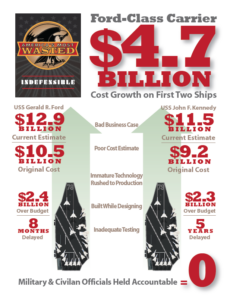
President Trump speaks to Newport News Shipbuilding employees above the carrier FORD.
Speaking today on the hangar deck of the almost-completed aircraft carrier Gerald R. Ford, President Donald Trump explicitly pledged to build “the 12-carrier Navy we need.” Ever since the USS Enterprise retired in 2012, the Navy has had only 10 aircraft carriers, with the Ford soon to be commissioned as the 11th.
On current plans, a twelth carrier wouldn’t join the fleet until 2022, by which time Trump may no longer be in office. That 12th carrier would be the Ford’s sister ship John F. Kennedy, and the fleet would drop back down again to 11 three years later when the aging USS Nimitz turns 50. However, the Kennedy‘s current date is the result of five years of delays, so, conceivably, an infusion of extra funding and presidential pressure could accelerate production, albeit with considerable inefficiency.

Graphic courtesy of the office of Sen. McCain
Trump has promised to make defense spending more efficient. Once the Budget Control Act caps, aka sequester, are repealed, the businessman turned President said today, it will mean not only more funding but more stable funding, allowing the Navy to negotiate better deals with industry — “the same boat for less money.” There’s always been some tension in Trump’s rhetoric between emphasizing increased defense spending and emphasizing spending what we have more efficiently.
Trump didn’t specify a timeline for new carriers in his speech today at Newport News Shipbuilding, only the number 12. But giving a number is significantly more specific than he’s been in the past. As a candidate, Trump promised to build up the Navy to 350 ships. Given traditional proportions of different types, that would strongly imply 12 carriers, as retired Navy captain Jerry Hendrix wrote in December; Mark Cancian assumed 12 in his estimate for us of the cost of Trump’s plan; and the Navy’s official 355-ship plan explicitly includes 12 carriers. But implying isn’t promising.
Trump is still implying a lot more than he states, however. Consider his statement today that “our Navy is now the smallest it’s been since, believe it or not, World War I. Don’t worry, it’ll soon by the largest it’s been.” While that got lots of applause from the shipbuilders and sailors in the President’s audience, it had naval experts scratching their head. The largest the US Navy has been since World War I — the largest it’s been ever — was at the end of World War II, when it had 6,678 ships. Today’s fleet is 274, and just getting to 350-355 will take decades, let alone building six thousand. We can assume this is another case where, as veteran Trump-watchers like to say, we need to take the president seriously, but not literally.
Parsons, Rafael team up on competition to defend Marine bases from small drones
The two companies will likely have stiff competition in a tech space that has proven vital for the wars both in Ukraine and Israel.


























